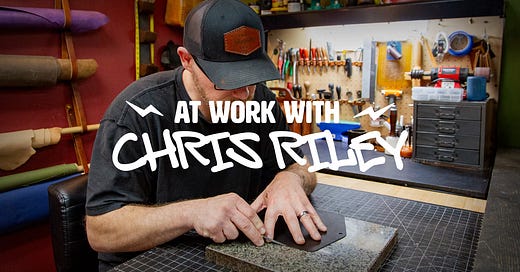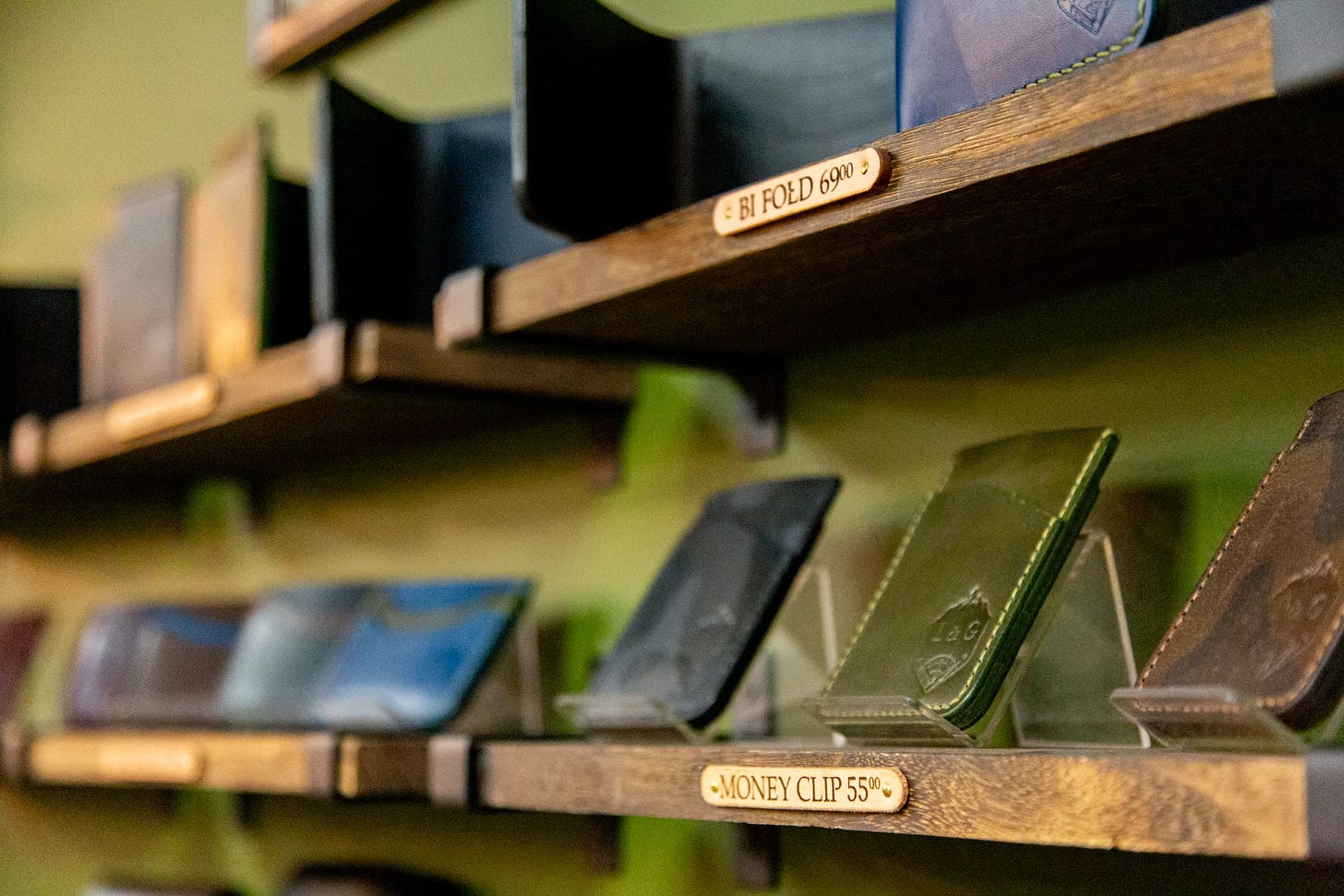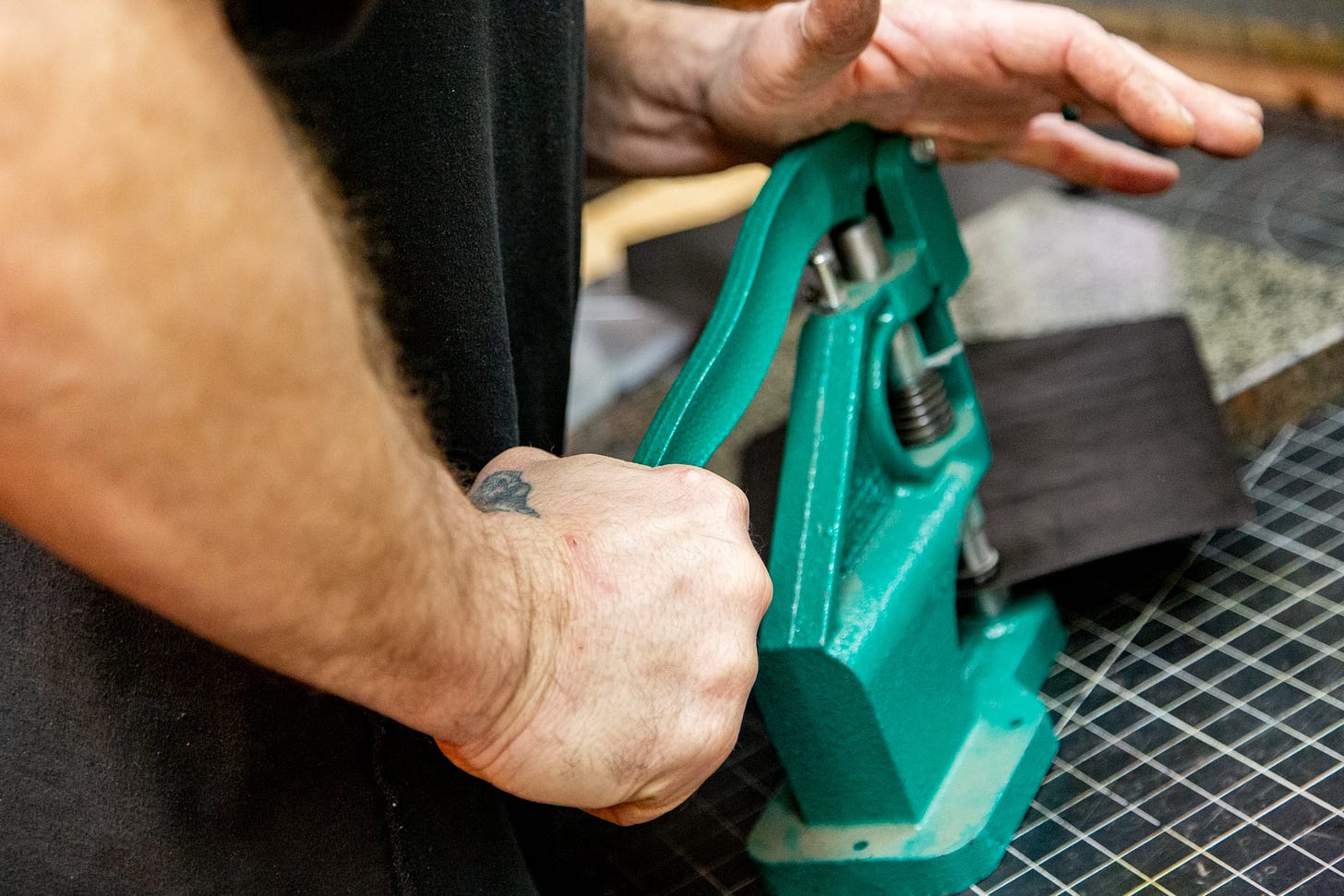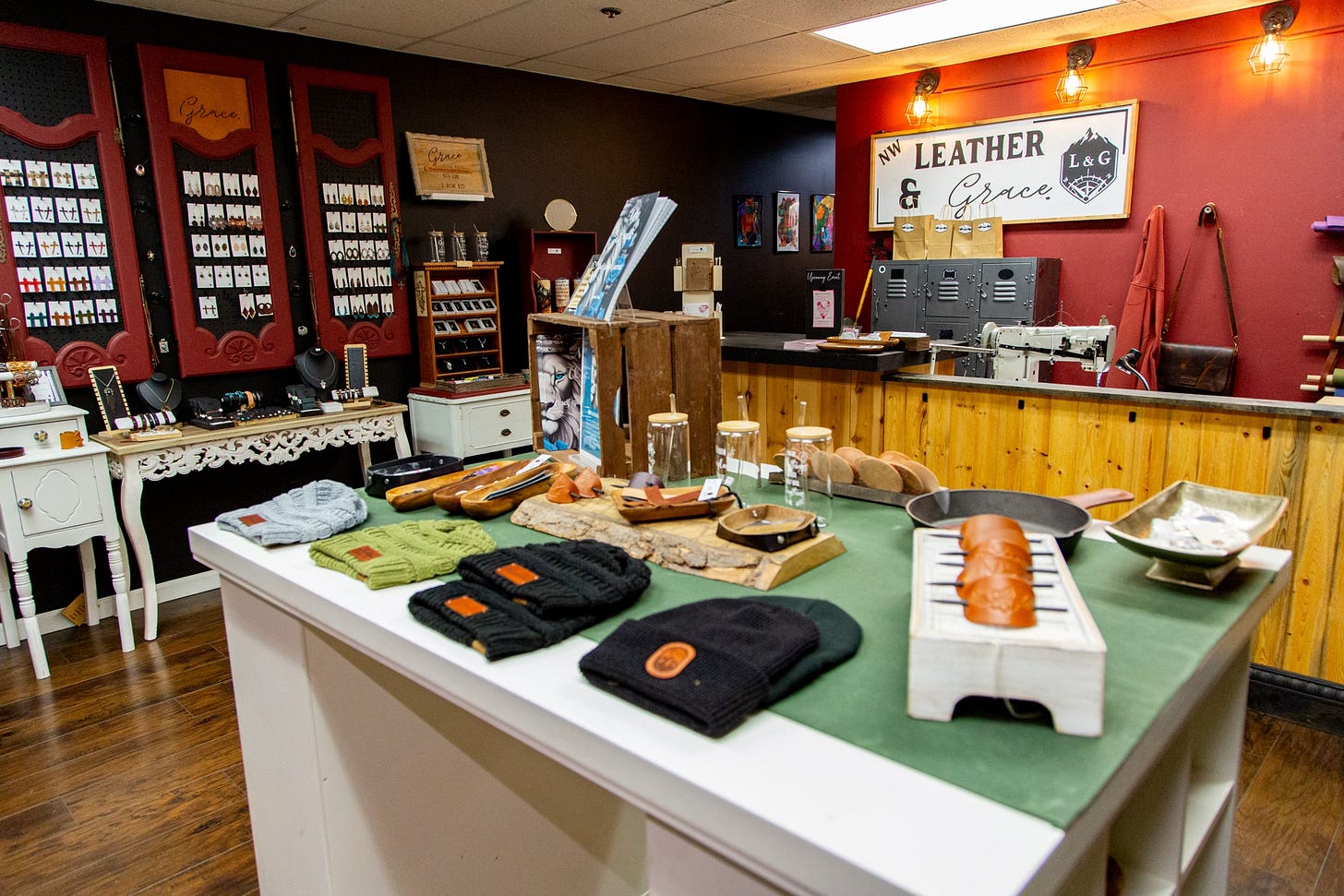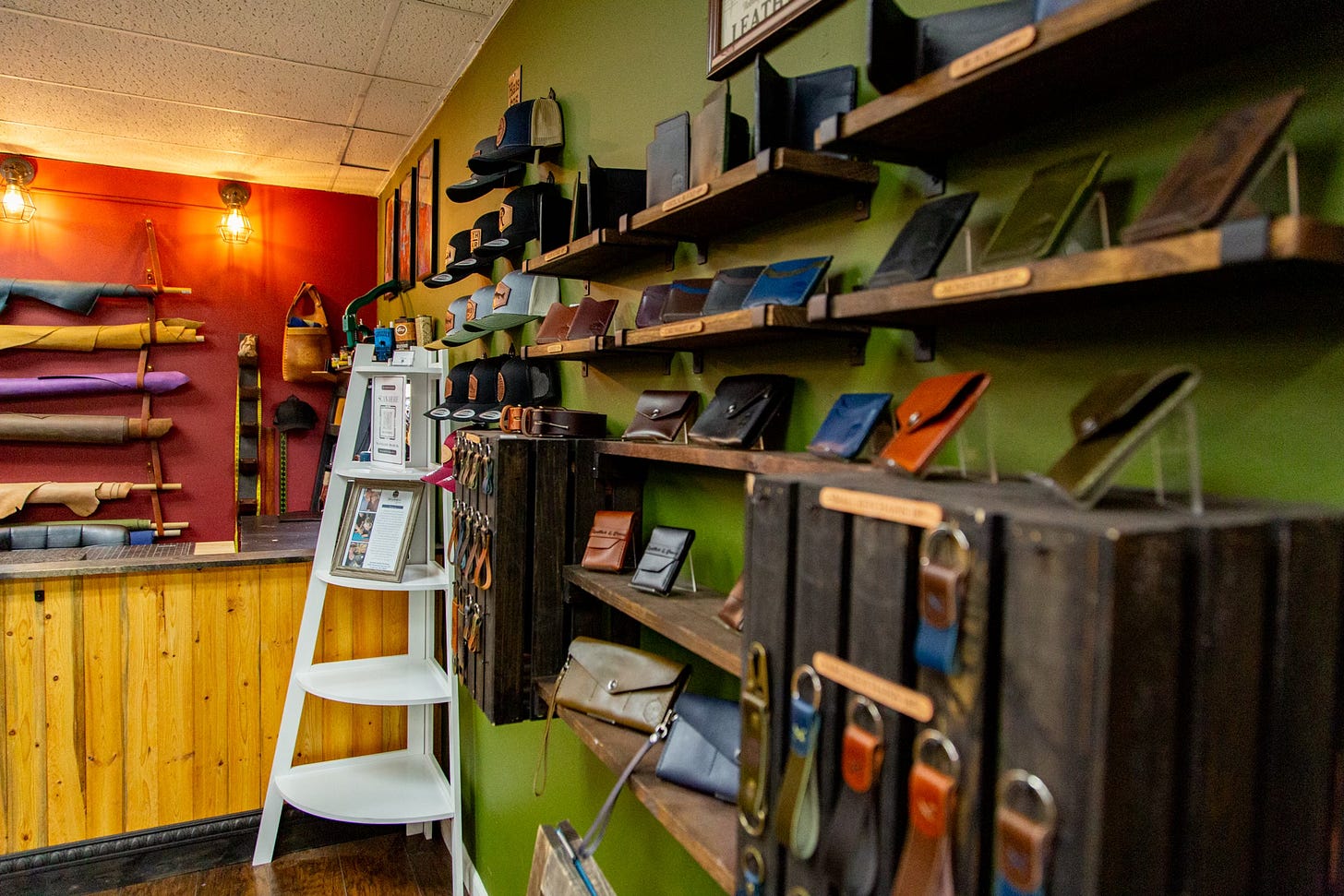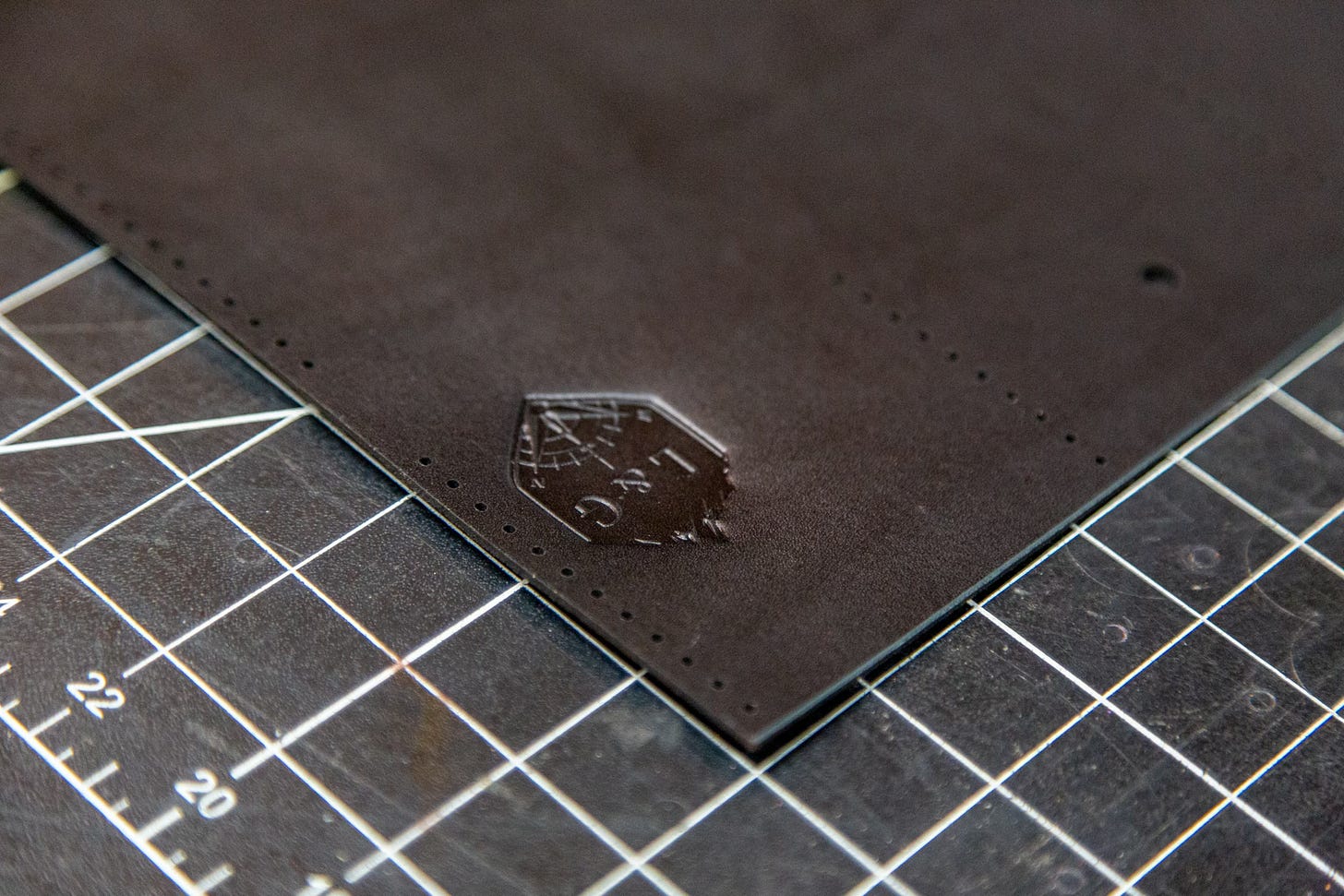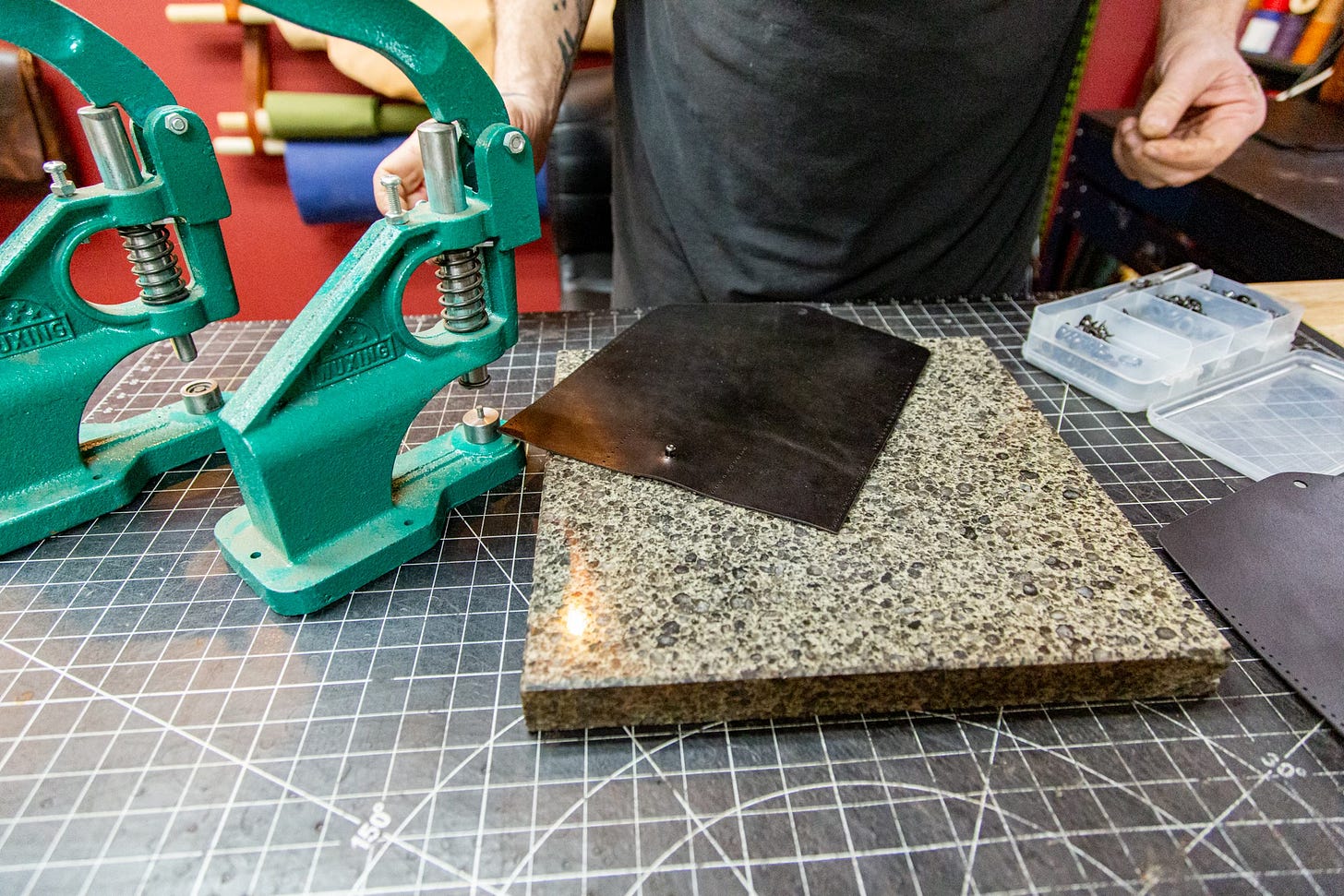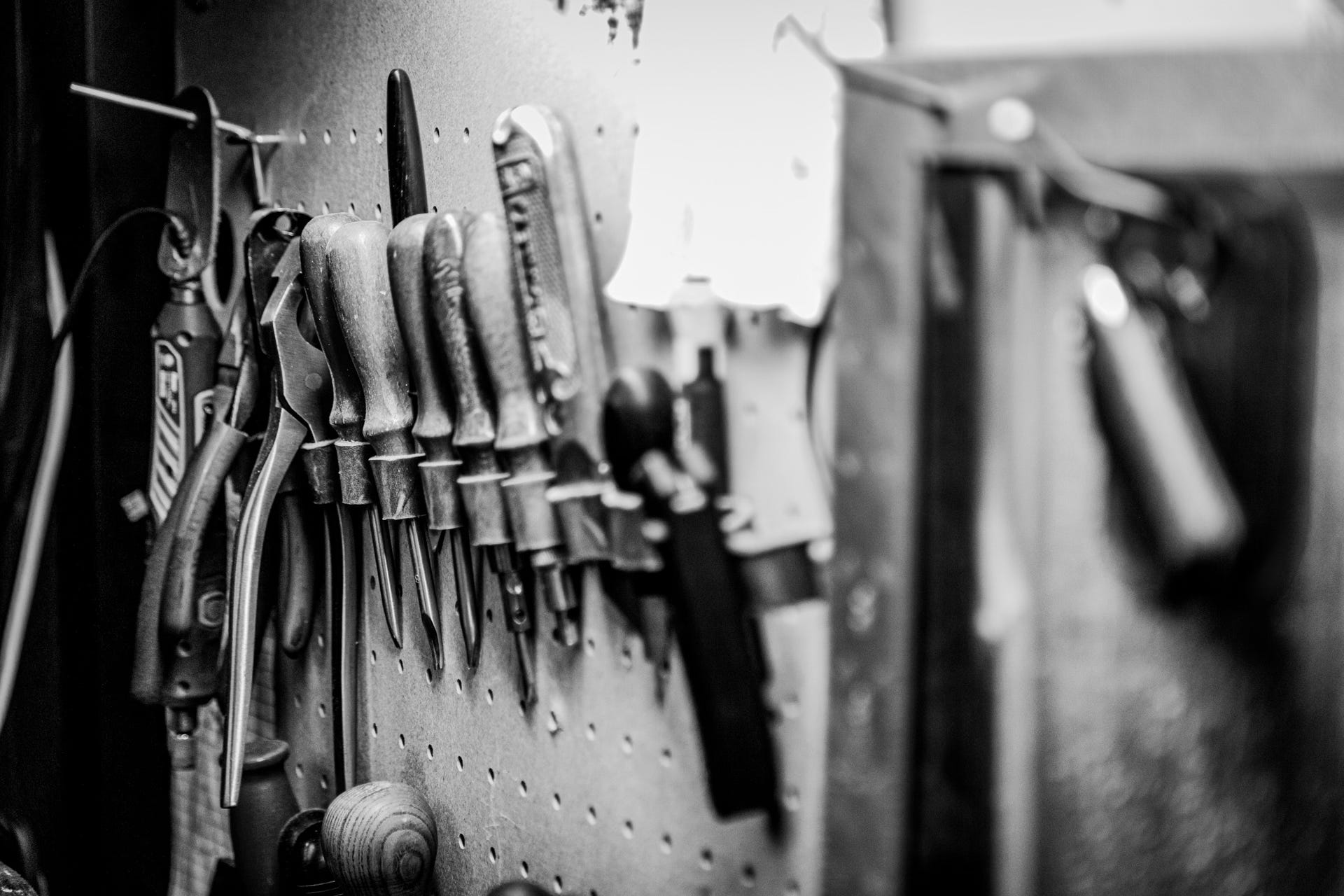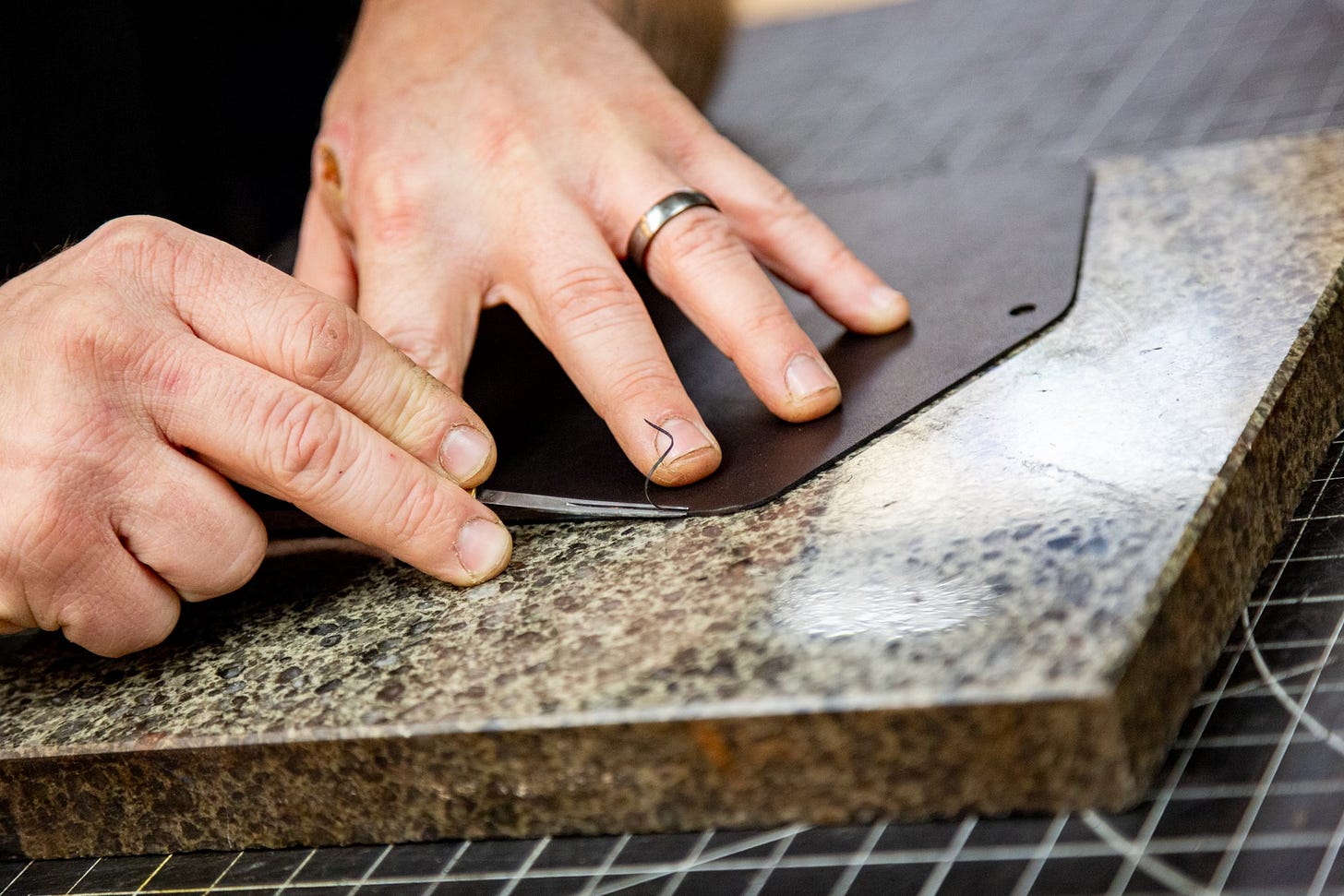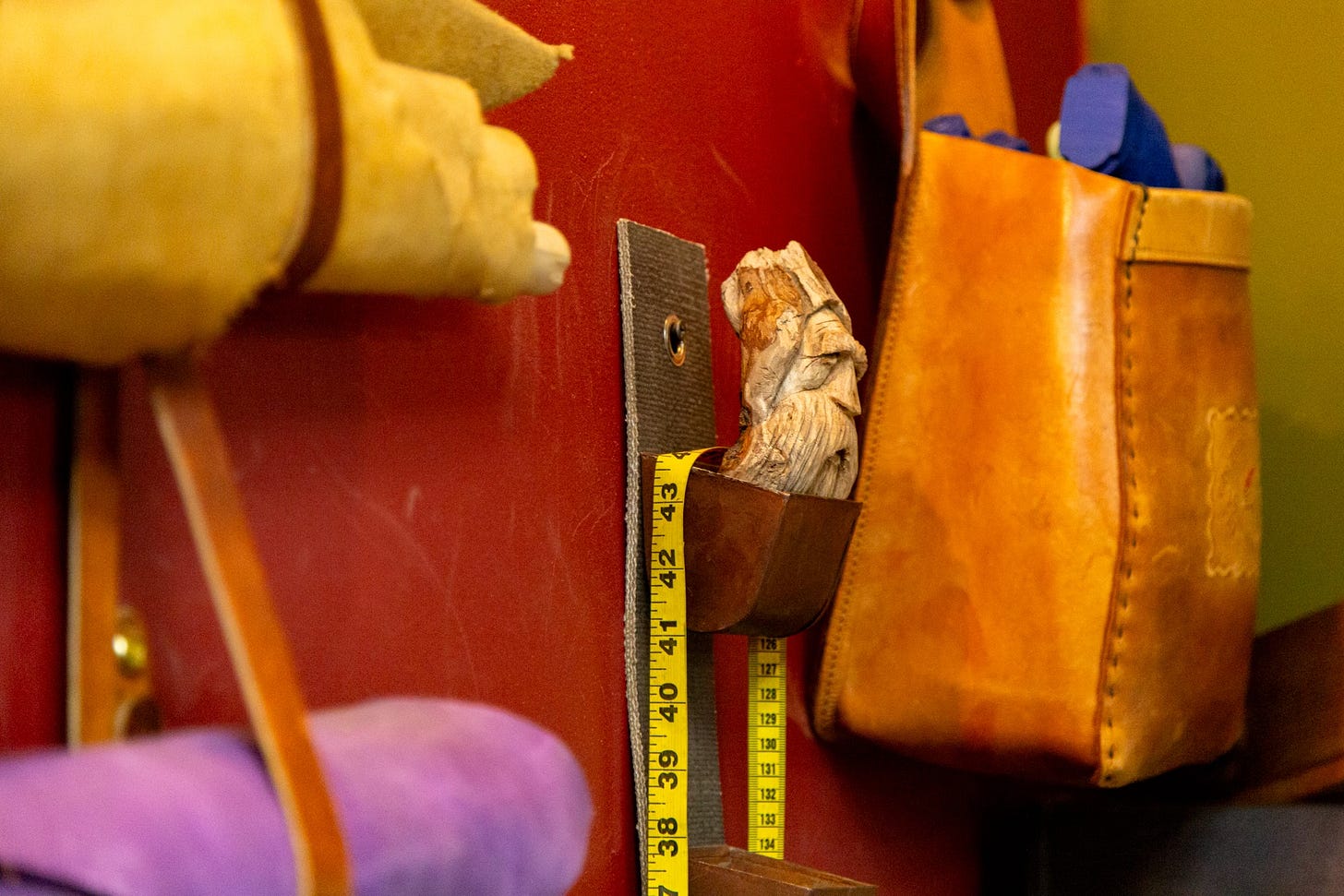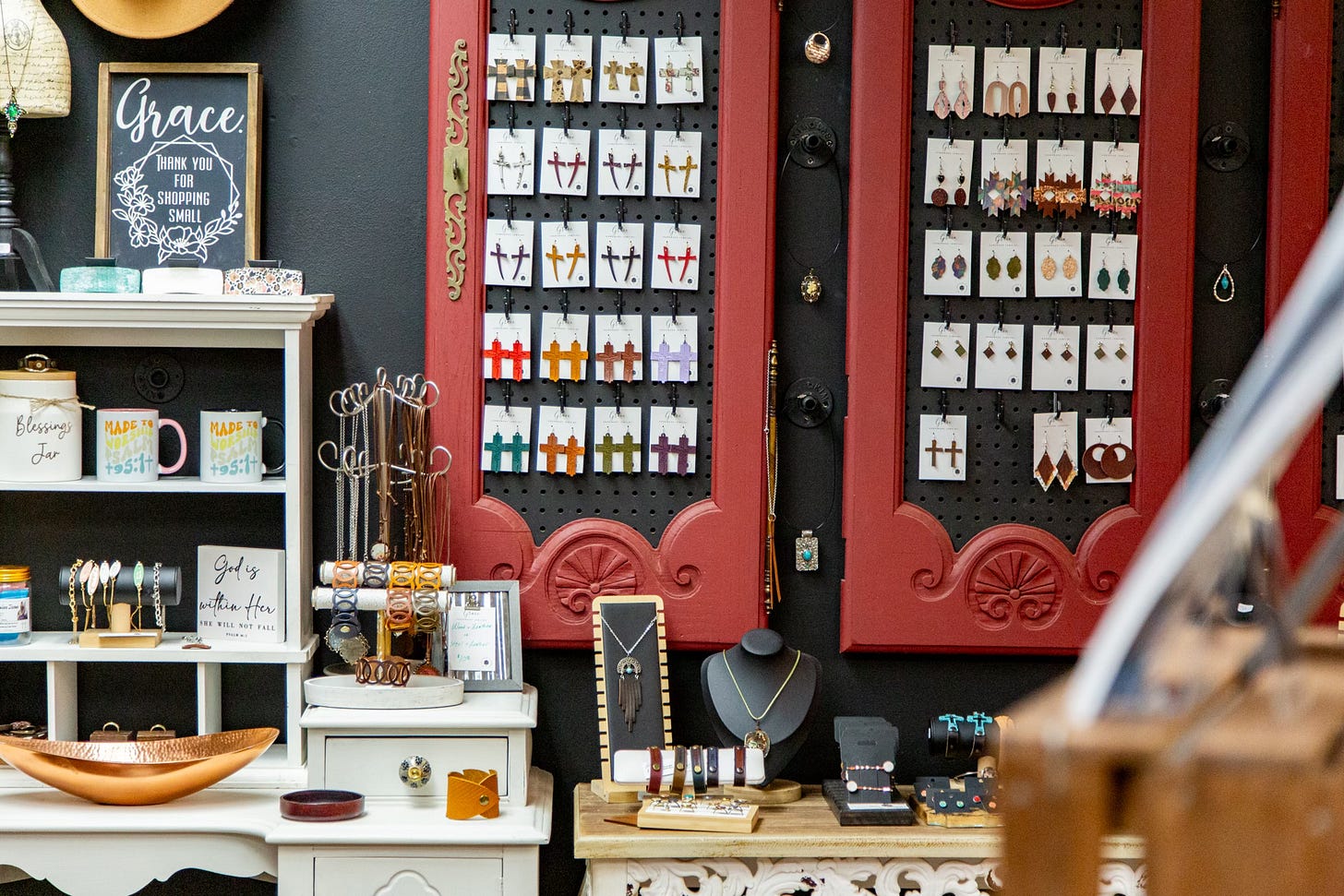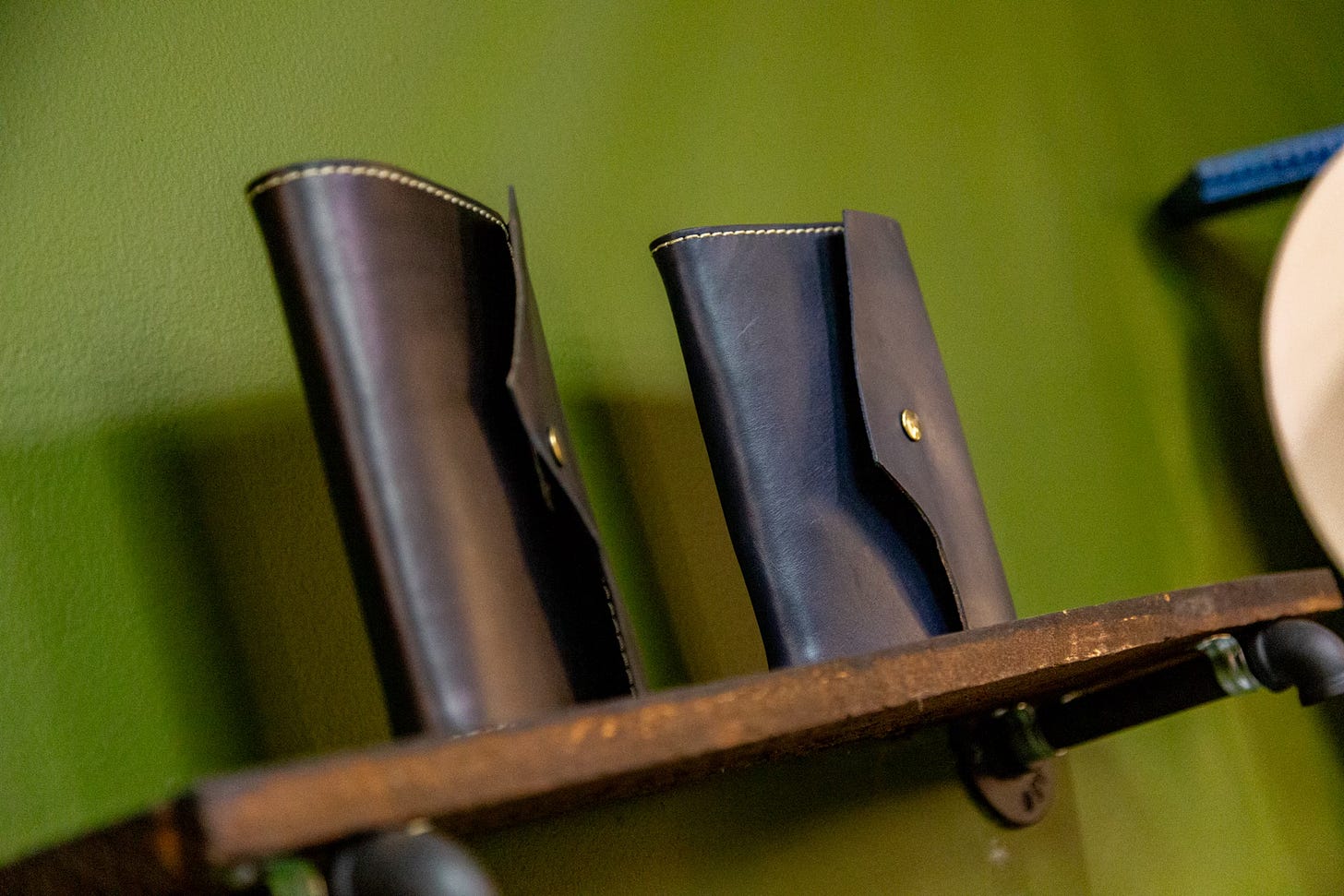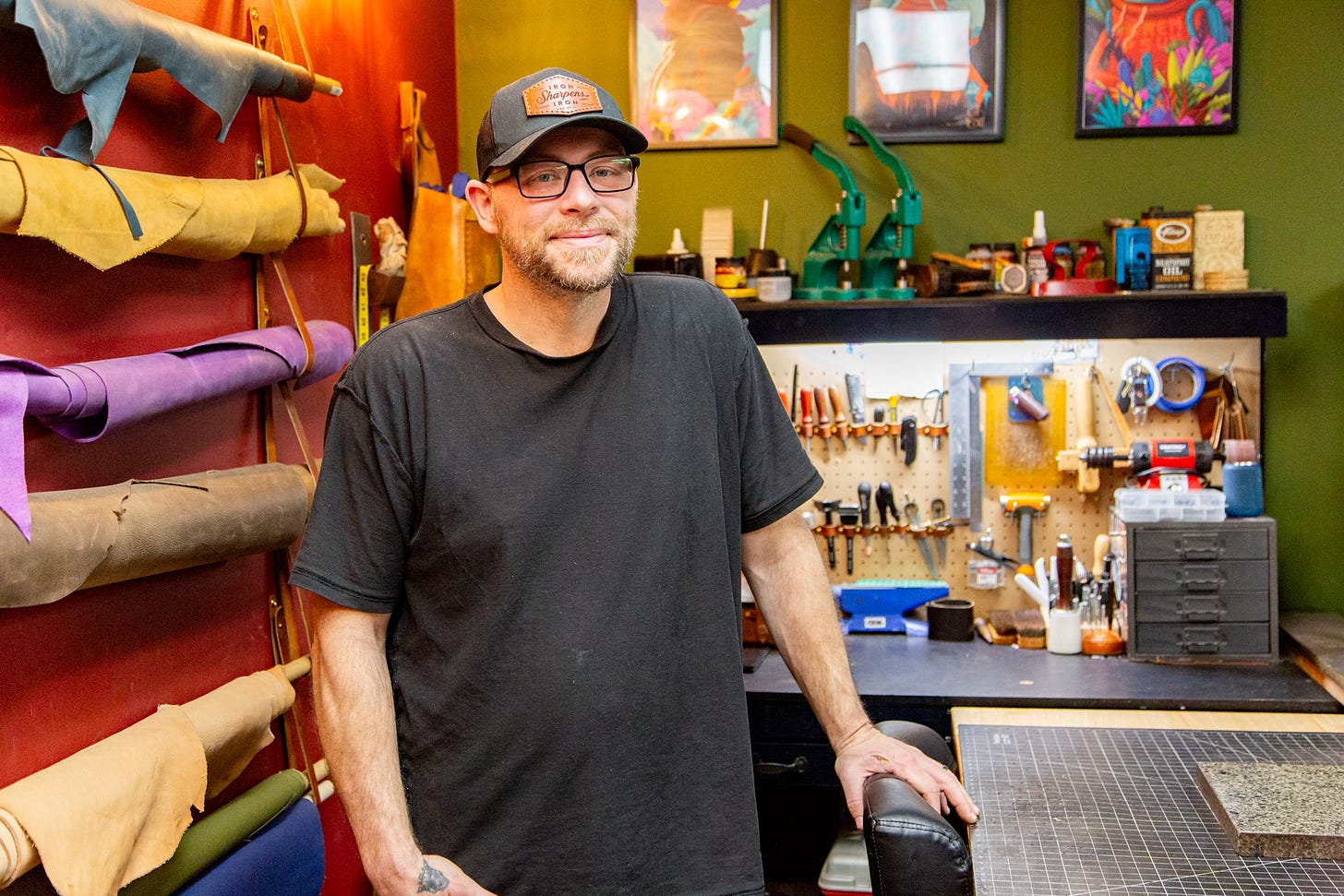At Work With Chris Riley
At Work With... is a monthly exploration of a creator's workspace and how it influences their creativity, curiosity, and artistic expression. It's a look at the curiosities and obsessions represented in artifacts, gear, tools, and knick-knacks. The surprises and hidden gems that reveal quirks and character. The objects that will never be thrown away for reasons known and unknown. It's all fair game and ready for the spotlight.
I’m sitting in an indoor courtyard across from NW Leather & Grace, the retail space and workshop for the husband-wife team, Chris & Jasmine Riley. Freshly baked chocolate chip cookies, coffee, and leather permeate my sense of smell. I’m traveling through time, reliving memories of growing up around horses, the earthy smells of saddles, tack, and hay. The chocolate chip cookies in grandma's kitchen. The coffee in front of me, in this moment. I hear the sound of work. Clanging and clattering. Scraping and sanding. I’m an hour early, eager to enter their world, but respectful of their time. So, I sit and wait, bopping to the music, collecting my thoughts, and going on imaginative trips through memories and the actual halls of The Merk in Longview, WA.
This is my conversation with Chris Riley at NW Leather & Grace.
One of the reasons for getting into people's workspaces is to see their workspace, obviously, but also to celebrate the person behind the work. And so, I would love to know who you are, what you do, and what got you into leather.
What got me into leather was wanting to make a bag for my wife; just make her something nice. I like to work with my hands. Before, I did a lot of the woodworking stuff. I just love creating things with my hands. It doesn't really matter what it is; I could do all kinds of things and enjoy it as long as it's with my hands.
Were there examples or models around you that said you could do that?
Well, my dad was in construction, and I can remember from the age of five going to job sites with him, and he'd give me a stack of wood, a hammer, and a bucket of nails and let me do whatever.
My parents would tell me that as long as they could remember, I'd be that kid that's pulling apart the radio, and putting it back together just to see how it works. So, I think it's just been that way forever. I'm really into how things work and how things are made. I love taking stuff apart and fixing them.
When you were making the purse for your wife, did you deconstruct it in your mind? Or did you buy a cheap purse and dismantle it so that you could see the pieces?
Yeah, in my mind, I just looked at it and pulled it apart in my brain. I kind of guessed on some measurements, and I'm really good at making blueprints in my head. When I walk into buildings, I like to deconstruct them and see the structural points and why things are made the way they are. It's just like a full blueprint in my brain.
Wow! That's a special skill!
Yeah, I'll try to talk to my wife or tell her something about it and she's completely different. She wants the blueprint on paper. She wants to see it. She wants to know and follow the steps. And so, I can create those steps for her. It's a really good balance. But yeah, you know those TV shows where they'll show a building and they'll pull it apart?
That's kind of what it does in my brain. So, it's fun.
How do you manage that? Because that can probably be overwhelming at times. When you know you need to sit down and work, but then if you're in mid-deconstructing view in your mind...
I don't ever start on something until I've got it all worked out. I won't even make a cut until I've got it all laid out, I've got my measurements. And most of the time it works out. Sometimes you get those instances where something will end up a little smaller than I had thought, or a little larger, but most of the time, it works out.
If I'm building a wallet, I just see, "Okay, this one needs to be..."—and I do everything in millimeters—"...about 120 millimeters." And then I'll sit down with my computer and design up everything in Illustrator.
Oh, wow.
All my templates are in Illustrator and then I build it on there. That helps a lot, too. I'll tweak the little things, and most of the time, it's pretty close to what I need.
What a perfect use of Illustrator because in a way that's what it's designed for, that very precision.
I'd never used it before, and so, when I first started and I was making my own templates, I remember our bi-fold wallet, it took me at least 20 hours to figure it all out in the computer. And now, I can sit down and do a wallet in like 15 minutes. A lot of it's knowing the measurements, like how wide a pocket needs to be for a credit card, and those things.
It was very confusing at first. I'm not really a big tech person. I don't really navigate computers, electronics, and stuff like that. It doesn't click, so it took a while.
And that's the thing that I love because your workspace is two-thirds retail, and one-third workshop, and I don't see a computer, which is amazing. It's unbelievable.
Yeah, it hides in that bag right there, and it just comes out when it's needed. I'm just not a huge fan of technology and electronics. In the leather, I try really hard to honor the traditional aspects of leather crafting and I just like that more.
Things were better back when they did things by hand in traditional craftsmanship, and you don't find a lot of that anymore. When you buy a belt from Walmart, it's genuine leather, it's produced by a machine—and it shows—it only lasts for six months or a year. And I think that's a lot of just educating people.
People come and say, "Oh, this jacket is genuine leather, it's amazing, I got it for a really good deal," and I'm like, "It's genuine leather, and it's not gonna last you very long. That's why you got the deal." But they don't know it. They see genuine leather, they think, expensive. They think that it's quality.
But in reality, you want to see full grain. So, people don't know, that's not really known out there. Every once in a while you'll get a customer, "Oh, is this full grain leather" and you're like, "Oh, yeah, you get it. You know." Those are the customers that don't hesitate about price. They see the quality and know why they're buying a $70 wallet.
You mentioned that this space really came out of the pandemic when you were in a previous space. So why create a workshop that's part-workshop and part-retail?
I think a lot of that was we wanted to test the market and see what people would think. We really thought people would like to watch me work as well, but it also brings that quality aspect to it.
When you tell somebody at a market that you make things by hand, they kind of get it, but they don't really get it. When they come in here and see me making things by hand, they're like, "Oh, you're the crafter." You see a whole different light switch come on. And, that helps with the reputation of it, I guess you'd say, and the brand loyalty too.
People want to come back because they know you're making it. They share part of you in that. "I know the crafter. I met the guy that made this." Things like that. And so, just by testing the market, seeing what people thought, and how people reacted with it, it showed us that it's an important piece.
I tried to give myself as little room as I could without taking too much of the space.
When you were laying out the workshop here—we're in a very narrow space here—and yet at the same time, it all makes sense. How long did it take you to really get this dialed in?
For me, I walked in the door and saw it blueprinted in my brain. I told Jasmine, "Oh, we'll do a wall right here and put my stuff and lay it out like this." And she's like, "I'm not sure if it's going to all fit like that." And I'm like, "No, I can see it. I already built it in my head." Then I got out the tape measure and started marking off space. In my mind, it looks exactly like it did within two minutes of being in here. I don't know, it just works like that.
Now, leather crafting or leather working?
Crafting.
Okay, because I know the terms are often used synonymously.
Yeah, and it's weird. It's like, "Are you an artist or are you a crafter?" Well, you're kind of both. But, the technical would be leather crafter, from what I understand and what I feel.
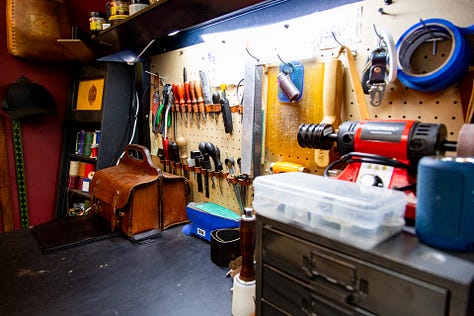
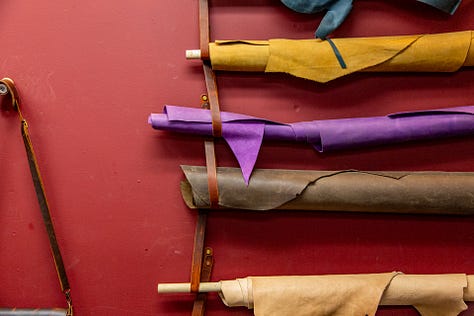
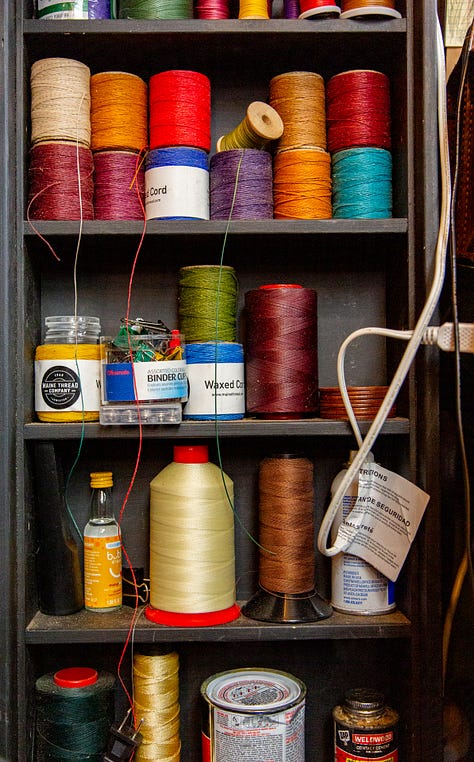
Usually, you go into a workspace, and I don't know, there's something hidden. I don't know if the tradition isn't there in some crafts and art. But it's very clear to me on what your workshop represents. You see the tools on the wall, the pounding surfaces, the leather on the wall. It's very clear what you do here. I like that that is represented.
Yeah, I like it, too. We put a lot of work into what our brand looks like, so it's clear. That took a lot of time. As far as the space and stuff, even with the paint colors and stuff, it's just truly us. It's who we are, it's not hard to pick out the paint colors, and the aesthetics of it all. But building that brand ID and having a cohesive feel was the battle.
Because that's inherent in your name. You have Leather and you have Grace. You have Chris and you have Jasmine. And, and you have the olive and the maroon, and everything just kind of works though.
Yeah, exactly. The maroon is Jasmine, the olive is me. We want to have a very Pacific Northwest feel to it. It took us a while to really kind of narrow in what that felt like. And that's more of the two-tone wallets. It's the playfulness of the colors. It's our roll-top backpack. We like being out and hiking. We go on a lot of day trips. We want that feel to it.
We want the gun holsters, the rifle slings, the custom knife sheaths, and those things. Part of that's where we live, you know, we have a lot of that around here. But, that's also who we are. It's what I enjoy doing. I could make this same wallet a hundred times, and it's never gonna feel better, it's never gonna get more exciting. But, I'm gonna work on two gun holsters this week that have special cutouts for sights and stuff and that's the part that's fun. It's the challenge.
Well if you made the same thing all the time it gets pretty boring.
Yeah, it takes the joy, too. It takes the fun out of it.
And part of the craftsman journey is really that growth and challenging yourself every day.
Yeah, and through that you, you start finding the look of everything. You start finding that cohesiveness. But it's been a journey, and we're finally getting to that point where it feels very us. There's not a lot of leather shops out there to like compare to, at least physical stores. You can go online, it's not that hard to jump on Instagram and find a leather crafter sell and stuff, right? A lot of it looks the same, and you'll find a lot of people who do the same patterns, the same wallets.
And that's a part of our business too, that we've slowly worked on, I make all my own patterns, so at some point soon, we're going to hopefully put those out on the internet to purchase for home crafters.
It was weird because in Cathlamet, WA, the customer base and the clientele is completely different. I was doing more of those knife sheaves, those gun holsters, custom ammo belts, things that really fit what I wanted to make. As to here, it's more off-the-shelf wallets. I've went from more of a custom crafter to a production line. And so now I'm stuck in that spot like, that's not where I want to be. I want to tweak that a little bit.
Recently, The Daily News did an article on us here, and when they did that, that brought in more of that custom stuff which was great because then that helps with that production line assembly stuff.
I just love that it doesn't matter the craft, it doesn't matter the medium, the struggles are real across all. You have the manufacturing production line side of your business and then there's that side, "If I have to make another 'this,' I'm gonna go nuts," but then you get those custom projects or even your own ideas where it's like this was right.
And it's funny too because when I do the wallets, I like to do batches and not mess with it for a few weeks. Last week, I did 18 wallets. It took the whole week and it was miserable. It was the same thing every day. Hand stitching, it doesn't change. But once you get to that end, once I see that final wallet and I get the edges all smoothed out and glossy, and it's a final product, then it feels good. It feels worth it.
But as soon as somebody came in and they bought one of those wallets I made, I was like, "Yeah!" It's still exciting to see them go out. It's fun to watch something that you've crafted with your hands, go to somebody that's going to love it for a long time. And now that we've been around long enough, we have customers that are coming back.
I had one guy that stopped by our booth at the lake on the 4th of July. Every year, they do a big thing, and we've been there every year. And a guy came in and he was like, "Man, will these last?" And I'm like, "Yeah, I make them by hand. They're full grain leather." I told him all the key points. And he just wasn't sure.
He's like, "I blow through a wallet like every six months." And he has a physical job where his clothes get torn up, and he's rough. And I was like, "It'll last." It took a little bit of talking him to, and he finally bought it. And now every year, he comes back and he's like, "Year four." And I'm like, "Yeah." He just stopped by the other day and was like, "It's still going strong."
So those things are part of that reward. When somebody comes in and shows us a wallet, I get to see the patina and see how it ages individually with each person. And that's what kind of the fun thing about leather, when those people come in, that makes those production days more worth it.
Because at the end of the day, even if it's mindless and it's the same wallet I've made a thousand times now, to that person it's special. To that person it's unique and it's theirs and that's fun. And it's not gonna end up in a landfill. It'll probably be given to his kid.
Is there an object or a tool that showcases your curiosities and your obsessions? Object or tool?
I'm not sure. I think it kind of all encompasses that; the obsession is just the crafting. It's making the products. I love tools. All my tools are different and I love every one of them because of how they work.
I love that you mentioned you bought a cheap kit, because I recently bought one on Amazon. When you open a brand-new kit, it's all cattywampus, thrown about, and looks the same. When I look at your tools, I see the age of use.
I use this for burnishing the edges, but a new one comes like a natural piece of wood. I've cleaned it up a little bit. I made that mistake of cleaning it and like getting rid of some of that age and distress on it. But yeah, this is the original one from the cheap kit that I got. And I use it almost every day.
And that's the thing, that's part of the approach: You learn what works and what doesn't. What you need to get better things of.
Like, can I go out and buy a rosewood that's beautiful for 30 bucks? I could. This one's gonna work better because over time, the wood has been compressed, it's been smoothed out, and it's just perfect for what it needs to be. It doesn't matter that it came in a cheap kit.
Now, things like these little edge bevelers—they run over the edge—you don't want a cheap one of these, you know, they dull real fast. You're continuously trying to sharpen them. You get a nice quality one, it might be 80 bucks for this one tool, but I'm not going to have to replace it ever possibly.
And it's also things like supporting other local makers. This was handmade for me. And that also comes with a price, but you're, you're supporting another crafter. I will have this forever, too.
In two instances you opened drawers and brought out things that are hidden. What would people be surprised to know that you have hidden away from public viewing?
I don't think there's anything that's like a real big shocker, everybody's got a junk drawer with all kinds of randomness in there, right?
I love the handcrafted tool that you said that you got from another crafter, but is there another tool that has some of that history attached to it? Maybe from another leather crafter or from a family member?
I don't have much. I know that Jasmine does tooling—she's been learning it and attempting it—but she's been given some hand tooling stamps that are from the 60s and 70s from people whose dad did it. And it's kind of fun when people bring us stuff like that. You can almost feel the life that it's had.
There's things like this bag, I get asked all the time if I made this. I found this bag before I ever got into leather crafting. I just loved it. It's some sort of motorcycle club saddle bag, and I stick my blue guns in it for molding my holsters.
I like those things around because you feel that life. I don't know the crafter that made it, but somebody made that. And it gets your brain going. This is another fun little thing that some clients of ours made after I made them a custom knife or gun holster, and a shop apron. He's a wood crafter.
So he whittled this by hand. When I see this, I see him sitting down and carving it and spending his time on it. Those are the things that I love because there are stories and people there.
What should you get rid of, but you know you won't.
I probably have a lot of tools that are lower quality tools and stuff that I just don't really need. But I never will. You never know if you're gonna need that one weird thing that you bought that you used once and forgot about. That being said, you've seen those two big tubs of scrap leather in the back, I have like three more of those at home. They're just in storage. I should probably get rid of those. But there might be that one piece that you need to finish something or give you inspiration, right?
Some leather crafters sell scrap packs, and so I could probably box them up and make some money off of them if I wanted to. But my wife might be able to make a cool necklace, or it might inspire her to make a whole different bracelet design. We really try to use every piece we can.
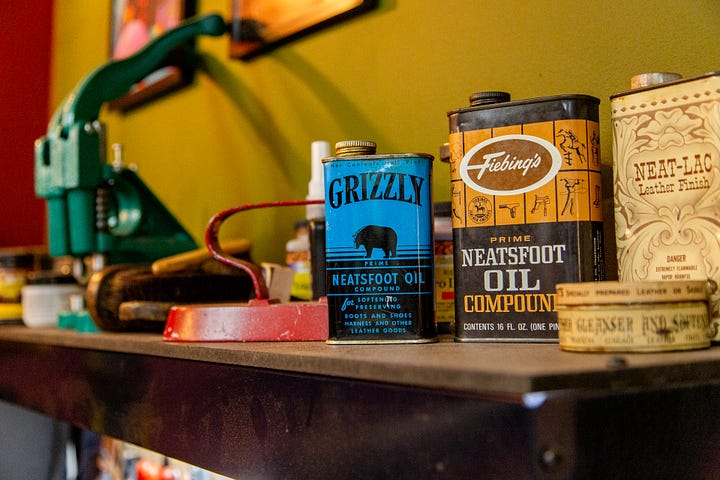
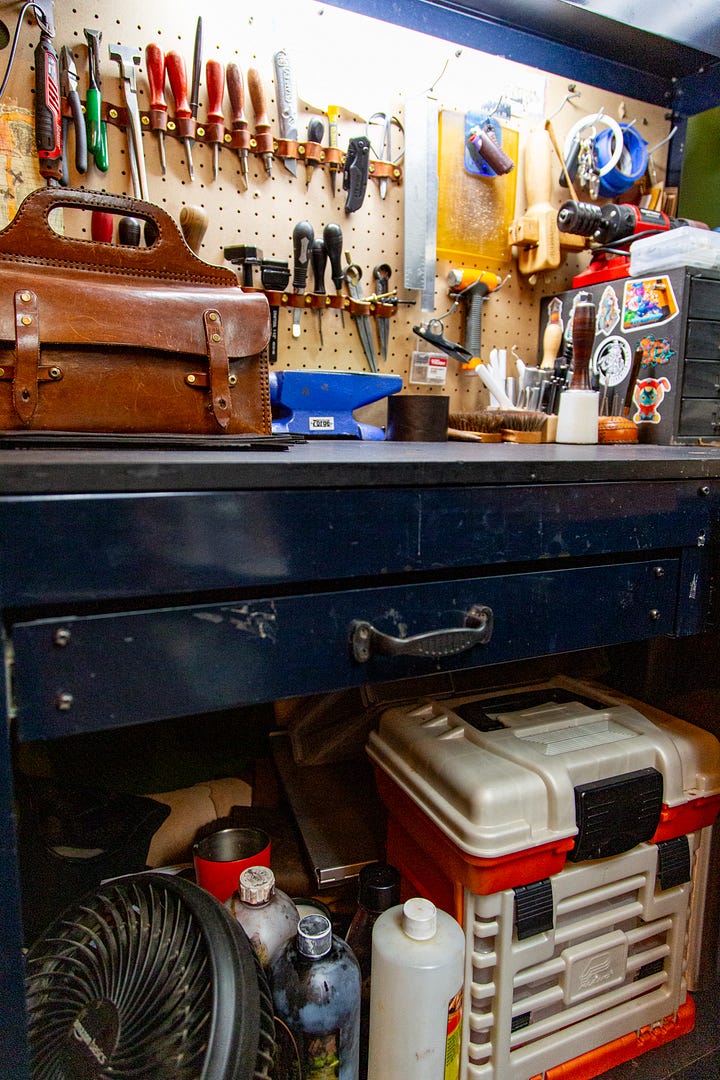
As a crafter you have things like leather dye and leather cream conditioners that are pretty much gone, has an ounce left in the bottle, and it's just taking up a lot of space. You could realistically just get rid of it. I have another brand new one, but it's not gone yet.
I've cleaned out my junk drawer like three times, but it goes from the drawer to a box on the shelf. It doesn't go to the garbage.
Leather has an amazing tradition looking backward. How do you look at it moving forward?
I try to bring it forward with me. It's like the hand stitching. I like the fact that people back in the day would sit there and put that energy into hand stitching because of the quality of product. I could use my sewing machine, but it's not going to be the same quality. I'm very traditional with clean lines, hand stitches, and shapes. Jasmine encourages me often to move outside of that box a little bit, but that's who I am.
Now, we'll try to tweak them in little ways, keep the tradition of it, but maybe make the curve a little different or make something stand out. If you're going to tool something, throw in some traditional basket weave, but add kind of a modern stamp in with that to bring it a little more current. It's not so western-y, old school traditional, but more streamlined and elegant.
I think that if you create with leather specifically, there's a reason that those traditional aspects have been around forever. Once you start losing those is when you start getting bad quality stuff. I like to think that a lot of the work that we do is looking back, looking forward, and finding how you can bring those two into the moment so that growth happens in that realm as well.
Do you spend a lot of time seeking inspiration, or do you find inspiration in doing the work?
I think inspiration comes naturally just by life. When we're out and about, we'll see a color or we'll see a shape and we'll be like, "Ooh, that's fun."
On leather you have these natural edges—live edges is what they're called—and I like to play with that a lot. It's like those two journals up on that top shelf. That's not a clean swoop. It's not a straight line. It's just naturally how that leather ended. I'll find inspiration in that, too.
I cut out my own templates with a laser. I'll make a design, cut out an acrylic template, lay the piece of leather out on the ground—I get like half a cow at a time, it's called a side—and move the template around until I feel like something speaks to me. I'll be like, "Ooh, I like that edge or that won't lay cleanly." I like to play with those live edges and let the leather speak to you.
You're a leather whisperer.
It's fun. It's just part of the process of being an actual crafter and an artist. I don't get to do a lot of playing around with it, artistic stuff, but it's those moments where I get excited and I can see ten different journals. But only one of them is right. You know, so that one speaks to you.
That's cool. Chris, thank you for letting me into your workshop, and showing me the philosophy and reality behind all you do.
Yeah, absolutely. I appreciate you coming. It's fun to share.
Newsletter Notes:
Responses were edited from an in-person conversation with Chris Riley in NW Leather & Grace's retail storefront in The Merk in Longview, WA.
I used the following typefaces in the main graphic: HWT Artz by Erik Spiekermann for "At Work With" and Subway Berlin SC by Hannes von Döhren for "Chris Riley."
Dream Theater's Parasomnia was my constant sonic companion while editing the photos and text.


